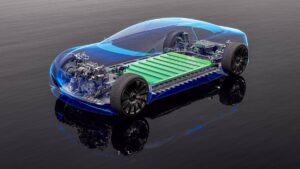Monsters of Rock: Expect more battery metals deals from copper hungry Rio and BHP

Pic: ALEKSEI BEZRUKOV/iStock via Getty Images
- Expert predicts more copper and energy transition metals from majors like Rio Tinto and BHP
- Rio announced a big investment to expand its Kennecott copper operations in Utah
- BHP says it’s on track to reduce operational emissions by 30% by 2030
BHP (ASX:BHP) and Rio Tinto’s (ASX:RIO) plan to conquer the world of battery metals is just beginning after iron ore giant Rio unveiled almost US$1 billion worth of investments to extend and expand the life of its Kennecott copper mine and smelter in Utah overnight.
Two of the largest copper producers in the world, both derive the vast bulk of their earnings from iron ore, the commodity whose price primarily moves the dial for the share prices of the world’s two biggest miners.
But both of the Australian giants are determined to dial up the proportion of their earnings that come from copper, nickel and in Rio’s case lithium.
Rio was also revealed today to have taken a smaller earn-in position to explore for nickel and copper targets near Lake Grace in WA via a deal with junior Sultan Resources (ASX:SLZ) and has been pegging ground in and around a clay hosted rare earths discovery in WA’s Wheatbelt revealed yesterday by Steve Parsons backed Cygnus Metals (ASX:CY5).
Betashares senior investment strategist Cameron Gleeson says Rio’s Kennecott expansion — which comes after its decision last year to fork out US$3.3 billion to buy out minority investors in Rio’s Oyu Tolgoi copper-gold mine in Mongolia — is “the latest in a long line of considered bets by large miners” on copper and other energy transition metals.
“Given its role as an essential ingredient in the global transition to a net zero economy, we expect demand for copper to remain elevated,” he said.
“While at the same time, supply is expected to remain structurally constrained as the metal becomes harder to extract. These twin forces will be supportive for copper prices over the long term and will stoke further interest in copper assets by larger diversified miners.”
The biggest trend
Amid a weak global economic outlook — normally the death knell for industrial metals like copper — the energy transition means the scramble for those assets is now “perhaps the biggest trend in capital markets this year”, Gleeson surmises.
“Iron ore remains the primary revenue driver for both BHP and Rio and they are certainly on the hunt for high quality assets to address their underexposure to copper and other energy transition metals,” he said.
“As a result, we expect no end in the spate of copper acquisitions and expansions by the likes of Rio Tinto and BHP, as they look to position their portfolio for the ongoing transition to a net zero emission economy.”
More is likely coming. With nickel and lithium in focus. BHP has already paid $9.6 billion for copper producer OZ Minerals, which is also building a $1.7 billion nickel mine in the remote West Australian outback called West Musgrave.
“While copper has been the first cab off the rank for both BHP and Rio Tinto, it’s our view they will perhaps start looking to build out exposure to other energy transition metals like nickel,” Gleeson said.
“At the same time, demand for Australian lithium assets continues apace, with several announced or completed deals in the works, including IGO and Tianqi’s (failed) $136m acquisition of Essential Metals and Ablemarle’s (rejected) bid for Liontown.”
BHP chases decarbonisation target as demand for green metals surges
It came the same day as BHP updated investors on its decarbonisation plans, saying it remained on track to cut operational emissions by at least 30% by FY30 on a “non-linear” path to Net Zero by 2050.
The presentation by head of carbon management, sustainability and climate change comes couched in the argument that miners, some of the world’s largest industrial emitters, will be crucial assets in the fight against global warming.
Electrification needs metals for renewables, electrical infrastructure and EVs.
BHP predicts primary copper demand will grow a total of 7Mtpa between 2022 and 2030, equivalent to seven of its Escondida mines. The Chilean operation also partly owned by Rio is the world’s largest.
Crude steel, copper and potash are all expected to see demand grow around 200% over the next 30 years compared to the last three decades, according to BHP’s internal 1.5C warming scenario. For nickel that is around 400%.
BHP is expecting to spend US$4b in decarbonisation capex to FY2030. That will include the deployment of electric vehicles to try displace diesel in operations like its Pilbara iron ore mines, with operational trials of Caterpillar dump trucks, Progress Rail and Wabtec trains and Liebherr excavators in 2024, as well as Komatsu trucks from 2025.
The miner expects battery operated truck opex will be comparable with running diesel vehicles, with deployment of fleets targeted from 2028 for trucks, around 2027 for excavators and from 2029 on for rail.
Meanwhile, it is planning for the rollout of 500MW of renewable generation and storage capacity before the end of the decade to supplement power supply from the 190MW Yarnima gas-fired plant in the Pilbara, and is exploring options to connect into the North West grid.
Perhaps more controversially, BHP says with currently available technology it anticipates up to 50% of its forecast methane emissions at the BMA coal mines in Queensland could be “extracted and actively managed”.
Coal companies like BHP and Glencore have previously been accused of downplaying the scale of methane emissions from met coal mines, which accounted for 32% of BMA’s operational emissions in FY2020.
BHP (ASX:BHP) and Rio Tinto (ASX:RIO) share prices today:
At Stockhead, we tell it like it is. While Sultan Resources is a Stockhead advertiser, it did not sponsor this article.
Related Topics

UNLOCK INSIGHTS
Discover the untold stories of emerging ASX stocks.
Daily news and expert analysis, it's free to subscribe.
By proceeding, you confirm you understand that we handle personal information in accordance with our Privacy Policy.








